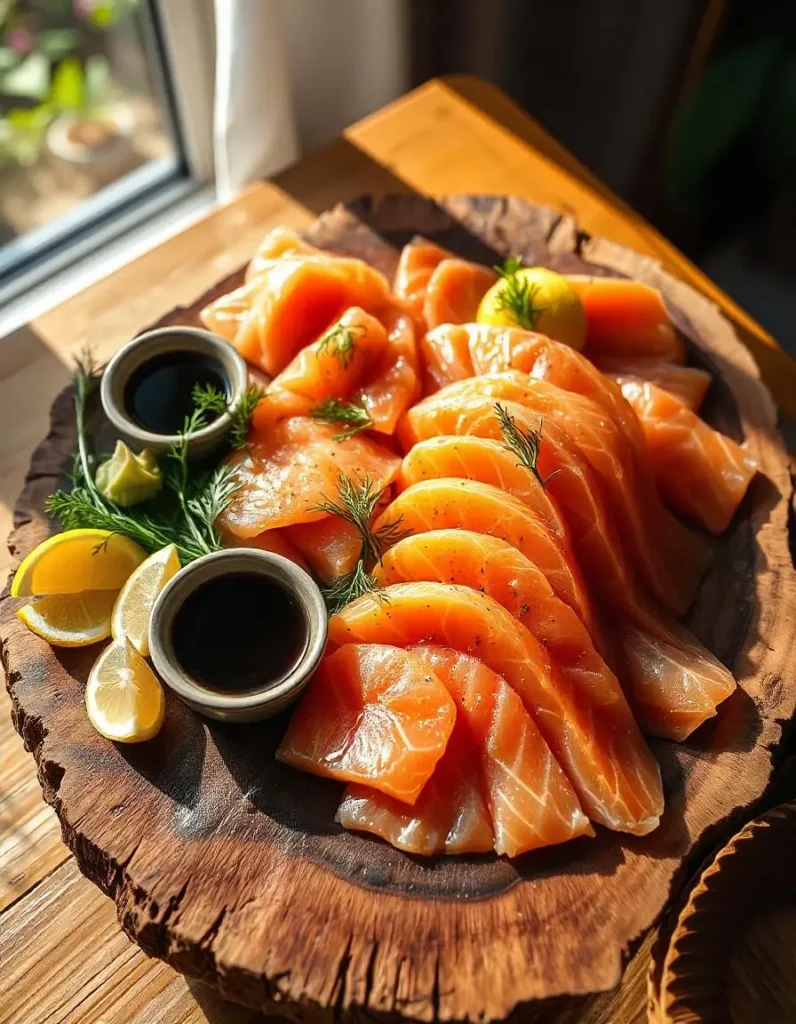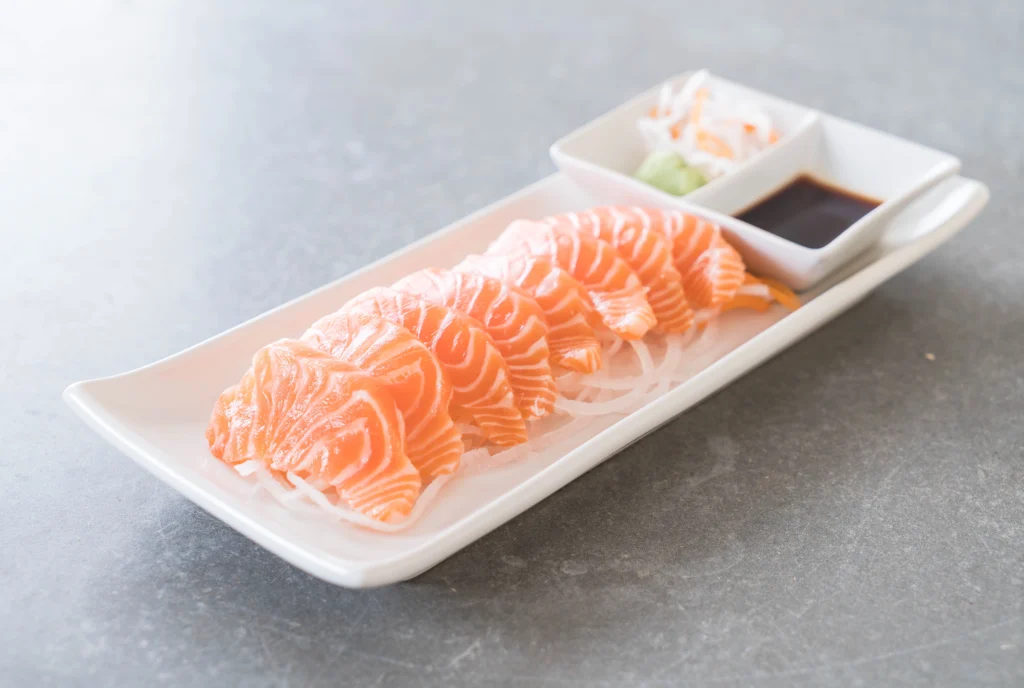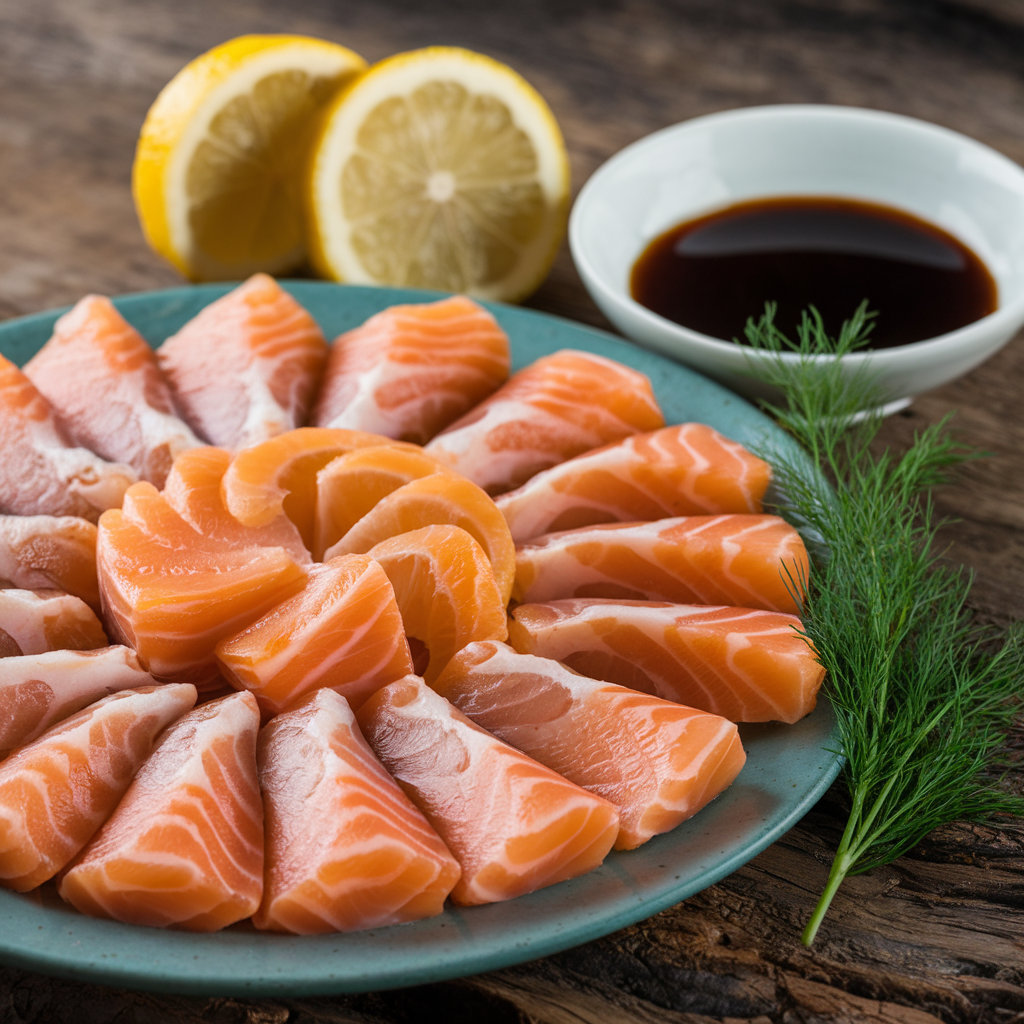Salmon Sashimi – A Complete Guide to the Delicacy
Introduction
Salmon sashimi, a beloved dish in Japanese cuisine, offers a unique and delightful taste experience. Combining freshness, simplicity, and culinary artistry, it is admired for its delicate texture and rich flavor. Not only is salmon sashimi popular in Japan, but people around the world also enjoy it. This dish often appears as part of sushi platters, at sushi bars, or served on its own. In this comprehensive guide, we will explore its origins, preparation methods, health benefits, and much more. Whether you are a sashimi aficionado or a newcomer to Japanese cuisine, this article will provide all the essential details to fully appreciate this exquisite dish.
What is Salmon Sashimi?
Salmon sashimi consists of thin slices of raw salmon served without rice. It ranks as one of the most popular types of sashimi and often appears in high-end restaurants, sushi bars, or even served at home. To ensure a superior experience, chefs carefully select the salmon for its quality and freshness. Furthermore, this dish emphasizes the natural flavors of the fish. Typically, people serve it with simple condiments such as soy sauce, wasabi, and pickled ginger, which enhance the overall taste.
The History of Sashimi

Sashimi dates back to the early 8th century in Japan, where chefs initially prepared it with fresh fish or meats that they often served raw or lightly cooked. Over time, sashimi evolved into the dish we know today, focusing on bringing out the purity of the fish’s flavor. However, became popular only much later, largely due to the growing availability of fresh, farmed salmon in the late 20th century. Historically, people made sashimi with local fish, but with advances in refrigeration and transport, chefs could source salmon more easily and serve it worldwide.
Why Salmon for Sashimi?
Chefs choose salmon for sashimi for several key reasons. First, the fish has a rich, buttery texture that makes it perfect for raw consumption. The natural oiliness of the fish contributes to its smooth and luxurious mouthfeel. Additionally, the flavor of salmon is relatively mild compared to other raw fish, making it an ideal choice for newcomers to sashimi. Moreover, people can easily source farmed salmon, making it more accessible than other wild-caught varieties. The beautiful pink or orange hue of the salmon flesh also adds visual appeal, making it an enticing addition to any plate.
How to Prepare Salmon Sashimi
Although preparing salmon sashimi at home may seem intimidating, you can easily make it with the right ingredients and tools. Below is a step-by-step guide to help you prepare and enjoy this Japanese delicacy.
Selecting the Right Salmon
To ensure the best quality, you must select the freshest salmon. When buying salmon for sashimi, look for fish labeled “sashimi grade” or “sushi grade.” This labeling indicates that the fish has been frozen to a certain temperature to kill any potential parasites, a requirement for raw consumption. The salmon should have vibrant color, ranging from deep orange to pink, and should have a clean, fresh aroma. In contrast, avoid salmon that appears discolored, smells off, or feels slimy to the touch.
Properly Filleting the Salmon
Once you have your sashimi-grade salmon, slice it into delicate pieces. The key to perfect sashimi lies in slicing the fish against the grain (the lines of muscle fibers). This method ensures a smooth, melt-in-your-mouth texture. A sharp filleting knife is crucial for making clean cuts. Ideally, slice each piece to about 1/4 inch thick, cut at a slight diagonal angle to maximize the surface area and visual appeal. To maintain freshness, keep the salmon chilled until you are ready to serve it.
Serving the Sashimi

To serve salmon sashimi, arrange the thin slices neatly on a chilled plate or platter. Many chefs prefer to fan out the slices, which creates a visually appealing presentation. Traditionally, people serve sashimi with a small dish of soy sauce for dipping, along with a dollop of wasabi to add a bit of heat. Additionally, pickled ginger, known for its tangy, slightly sweet flavor, often accompanies the dish to cleanse the palate between bites. Garnishing the sashimi with shredded daikon (white radish) adds texture and a mild flavor that complements the salmon.
Health Benefits of Salmon Sashimi
Salmon sashimi isn’t just a treat for the taste buds; it also offers a variety of health benefits. The dish provides a rich source of nutrients that promote overall well-being.
High in Omega-3 Fatty Acids
Salmon is widely known for its high omega-3 content, which is crucial for brain function, heart health, and reducing inflammation. These healthy fats are found abundantly in salmon and can help lower the risk of cardiovascular diseases, support cognitive function, and even reduce symptoms of depression. Notably, consuming salmon in its raw form ensures you retain more of these beneficial omega-3s, as cooking can reduce their content.
Protein Powerhouse

Salmon sashimi provides an excellent source of lean protein, which is essential for muscle growth, tissue repair, and maintaining a healthy immune system. Each serving of salmon offers a substantial amount of high-quality protein, making it an ideal choice for those seeking to support their fitness goals or improve their overall health.
Rich in Essential Vitamins and Minerals
Salmon also packs essential vitamins and minerals, including vitamin D, vitamin B12, selenium, and potassium. Vitamin D is vital for bone health and immune function, while vitamin B12 supports nerve health and red blood cell production. Selenium, a powerful antioxidant, helps protect the body from oxidative stress, and potassium is important for maintaining healthy blood pressure levels.
Pairing Salmon Sashimi with Other Foods
One of the great things about sashimi is how easily it pairs with a variety of foods and beverages. Below are some suggestions to elevate your sashimi experience.
Best Condiments and Accompaniments
- Soy Sauce: A must-have for dipping sashimi, soy sauce enhances the taste of the fish without overpowering it.
- Wasabi: Made from horseradish, wasabi adds heat and a pungent kick to each bite. You can either mix it with soy sauce or apply it directly to the fish.
- Pickled Ginger: This tangy and slightly sweet condiment often accompanies sashimi to cleanse the palate between bites.
Pairing with Wine or Sake
- White Wine: A light, crisp white wine, such as Sauvignon Blanc or Pinot Grigio, pairs beautifully with the delicate flavor of salmon sashimi. Avoid heavy, oaky wines that could overpower the dish.
- Sake: Traditional Japanese rice wine complements sashimi perfectly. Choose a dry, chilled sake for a refreshing and authentic experience.
- Green Tea: For a non-alcoholic option, warm green tea enhances the umami flavors of the sashimi while offering a soothing and cleansing effect.
Frequently Asked Questions (FAQs)
Is Salmon Safe to Eat Raw?
Yes, salmon is safe to eat raw when it has been frozen to the appropriate temperature to kill harmful parasites. Always purchase sashimi-grade or sushi-grade salmon from a reputable supplier to ensure the fish has been properly handled.
How Can I Tell If Salmon is Fresh?
Fresh salmon should have a bright color, firm texture, and a clean, ocean-like aroma. It should not have any off-putting smell, slimy texture, or discoloration. Always buy from trusted suppliers who offer sashimi-grade fish.
Can I Make Salmon Sashimi at Home?
Yes, you can prepare salmon sashimi at home, provided you use high-quality, sashimi-grade salmon. Ensure you have the proper tools, such as a sharp knife, and follow correct handling and storage procedures to maintain freshness.
What Are the Health Risks of Eating Raw Salmon?
While eating raw salmon does carry some risk of foodborne illness, choosing sashimi-grade fish and following proper handling practices minimizes the risk. Always store raw fish at the correct temperature and consume it within a day or two of purchase.
Can I Use Frozen Salmon for Sashimi?
Yes, you can use frozen salmon for sashimi, but it must be properly thawed and labeled as sashimi-grade. Freezing the fish helps eliminate parasites, making it safe for raw consumption.
Conclusion
In conclusion, salmon sashimi is not only a delightful dish, but it also offers numerous health benefits. Whether you’re enjoying it at a sushi bar or preparing it at home, salmon sashimi provides a taste of Japanese culinary culture. By selecting high-quality fish and mastering the art of preparation, you can enjoy this delectable dish in the comfort of your own home. Next time you’re craving something light and fresh, consider indulging in the beauty of salmon sashimi.

